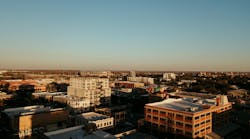Related search terms from www.waterinfolink.com: biosolids management, land application
Clare Pierson: When did Orange County begin its biosolids recycling program, and what were the challenges with getting it up and running?
William Hurley: Until 2003, the Orange County Utilities (OCU) Department disposed of biosolids generated at our three water reclamation facilities at the Orange County Landfill. Our water reclamation facilities produce approximately 15,300 dry tons of biosolids annually and space at the landfill is limited. We began to seek short-term, cost-effective and environmentally responsible solutions. After conducting research, we decided that land-applying our biosolids (after further processing) was the way to go.
We needed to find a contractor who could process the unstabilized biosolids prior to land application as well as maintain compliance with regulatory requirements. At the time, there was only one permitted biosolids processing facility in Orange County. We prepared our bid documents in a way that provided contractors the option of stabilizing the biosolids and then land-applying them, or disposing the unstabilized biosolids at a landfill that would accept biosolids. This approach opened up the bidding process to several contractors.
We also knew we would bring more visibility to our program because our hauling trucks would be traveling through neighboring communities. That led to a heightened awareness of our responsibility to those communities and agricultural land. This led us to implement the National Biosolids Partnership’s Biosolids Environmental Management System (EMS).
Implementing this system presented a number of challenges. For one, OCU’s three water reclamation facilities differed in day-to-day operations. By employing a biosolids EMS, we created standard operating procedures that helped our facilities run more efficiently and put everyone on the same page. From this, we were able to create formalized training classes for our facility operators and plant personnel.
Pierson: What advice can you offer to municipalities interested in starting a biosolids EMS?
Hurley: When we began creating our Biosolids EMS, our Biosolids EMS manual became a large and overwhelming document. While generating a number of ideas is good, we learned it was better to keep things simple and to go slowly. We decided to simplify the manual, which has worked well for our operations.
I encourage municipalities to figure out what works for them and create a simple biosolids EMS that is specific to their operations. I would strongly advise municipalities to obtain management and employee support in the development process at every level.
Pierson: What are some benefits of applying 100% of OCU’s biosolids as fertilizer to agricultural lands?
Hurley: Land-applying our biosolids allows us to complete the reuse/recycle circle. This means that 100% of our effluent is used for reclaimed water and 100% of our biosolids are used for land application. Our biosolids also help supply nutrients to the soil and agricultural crops in central Florida.
Pierson: Acreage of agricultural lands is decreasing in Orange County, thereby decreasing the need for biosolids. What will happen to the extra biosolids?
Hurley: Available acreage of agricultural lands is decreasing due to development and growth. Also, the Orange County Code is very restrictive as to where biosolids can be land-applied. The state of Florida is also proposing new regulations that would limit the areas where biosolids can be land-applied in central Florida.
The county is evaluating various beneficial reuse options to prepare for a future increase in biosolids production and to comply with upcoming regulations. Preliminary options under consideration include mixing biosolids with fly ash to increase the solid content and then using the final dried product as daily cover at the landfill, energy-recovery options and fertilizer production.
William Hurley is manager of the water reclamation division at Orange County Water Utilities. Hurley can be reached by e-mail at [email protected].
Download: Here

